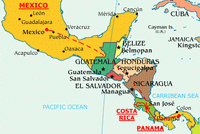Login form
Central America
 Between two great continents and two great seas lies a narrow strip of land. The land connects the continents of North America and South America. It separates the Pacific Ocean from the Caribbean Sea. It is home to tropical rain forests and once supported an ancient civilization. Today, a variety of people and societies exist there.
Between two great continents and two great seas lies a narrow strip of land. The land connects the continents of North America and South America. It separates the Pacific Ocean from the Caribbean Sea. It is home to tropical rain forests and once supported an ancient civilization. Today, a variety of people and societies exist there.
This land is called Central America. It’s a place where two continents and many different societies meet.
AN ISTHMUS
Do you know what an isthmus is? An isthmus is a land bridge between two larger lands. Central America is an isthmus that connects North and South America. But it’s considered to be a part of North America.
SEVEN COUNTRIES
Seven countries make up Central America: Belize, Costa Rica, El Salvador, Guatemala, Honduras, Nicaragua, and Panama. Spanish is the main language in all seven countries. English is the language used by the government in Belize, a former British colony.
The countries of Central America are home to about 36 million people. They include people related to the native Indians, plus people of Spanish, English, Caribbean, and African origin.
Most of the people in Central America are farmers. They grow coffee, sugarcane, cotton, bananas, and other fruit.
A RUGGED AND WILD LAND
Central America has many rugged mountains. The mountains rise steeply on the Pacific side of the isthmus. They drop gradually toward the Caribbean. Tropical forests cover much of the land.
Jaguars and pumas live in the rain forests. So do monkeys, iguanas, boa constrictors, and colorful parrots. The coastal areas on the Caribbean side are home to sea turtles and the giant manatee. The manatee is sometimes called a sea cow because it grazes on grasses that grow in the sea.
EARTHQUAKES, VOLCANOES, AND HURRICANES
Earthquakes are common in Central America. They can be destructive and deadly. There are also more than 100 volcanoes in Central America. At least 14 of them are still active.
Fierce hurricanes sometimes batter Central America, creating another natural danger. In 1998, Hurricane Mitch killed thousands of people and washed away whole villages in Central America.
ANCIENT CIVILIZATION
In ancient times, Native Americans used Central America to cross from North America to South America. Many people stayed on the land. One of the most important groups that stayed is called the Maya.
Over 1,000 years ago, the Maya built an advanced civilization in Central America. They erected impressive cities with huge stone pyramids and temples. Maya astronomers and mathematicians were among the world’s most advanced.
Today, the descendants of the Maya still live in Guatemala. They still speak the Maya language. The Maya ruins at Tikal in Guatemala are a popular tourist attraction.
PANAMA CANAL
The Panama Canal makes Central America a water bridge, too. The canal cuts through Panama and connects the Pacific Ocean to the Caribbean Sea and the Atlantic Ocean.
The United States built the canal between 1904 and 1914. It’s made up of a big artificial lake, river channels, and twelve locks. Locks are gates that can close off a canal. They allow ships to be raised and lowered to different water levels.
Before the Panama Canal was built, ships had to travel all the way around the tip of South America. The trip was thousands of miles longer and took many days. The canal is about 40 miles (64 kilometers) long. A trip through the canal takes only eight to ten hours.
Source: Microsoft ® Encarta

